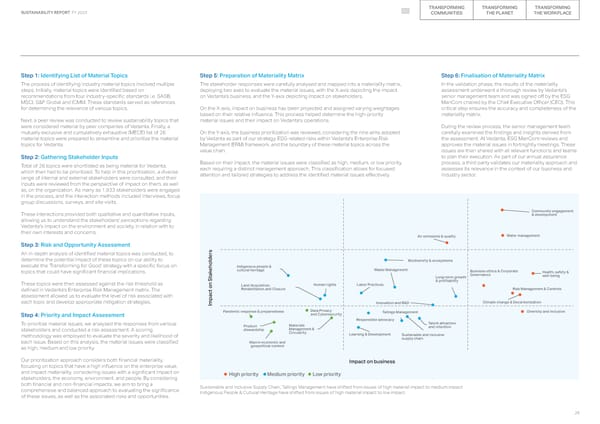TRANSFORMING TRANSFORMING TRANSFORMING SUSTAINABILITY REPORT FY 2023 COMMUNITIES THE PLANET THE WORKPLACE Step 1: Identifying List of Material Topics Step 5: Preparation of Materiality Matrix Step 6: Finalisation of Materiality Matrix The process of identifying industry material topics involved multiple The stakeholder responses were carefully analysed and mapped into a materiality matrix, In the validation phase, the results of the materiality steps. Initially, material topics were identified based on deploying two axes to evaluate the material issues, with the X-axis depicting the impact assessment underwent a thorough review by Vedanta's recommendations from four industry-specific standards i.e. SASB, on Vedanta’s business, and the Y-axis depicting impact on stakeholders. senior management team and was signed off by the ESG MSCI, S&P Global and ICMM. These standards served as references ManCom chaired by the Chief Executive Officer (CEO). This for determining the relevance of various topics. On the X-axis, impact on business has been projected and assigned varying weightages critical step ensures the accuracy and completeness of the based on their relative influence. This process helped determine the high-priority materiality matrix. Next, a peer review was conducted to review sustainability topics that material issues and their impact on Vedanta's operations. were considered material by peer companies of Vedanta. Finally, a During the review process, the senior management team mutually exclusive and cumulatively exhaustive (MECE) list of 26 On the Y-axis, the business prioritization was reviewed, considering the nine aims adopted carefully examined the findings and insights derived from material topics were prepared to streamline and prioritize the material by Vedanta as part of our strategy, ESG-related risks within Vedanta's Enterprise Risk the assessment. At Vedanta, ESG ManCom reviews and topics for Vedanta. Management (ERM) framework, and the boundary of these material topics across the approves the material issues in fortnightly meetings. These value chain. issues are then shared with all relevant functions and teams Step 2: Gathering Stakeholder Inputs to plan their execution. As part of our annual assurance Total of 26 topics were shortlisted as being material for Vedanta, Based on their impact, the material issues were classified as high, medium, or low priority, process, a third party validates our materiality approach and which then had to be prioritized. To help in this prioritization, a diverse each requiring a distinct management approach. This classification allows for focused assesses its relevance in the context of our business and range of internal and external stakeholders were consulted, and their attention and tailored strategies to address the identified material issues effectively. industry sector. inputs were reviewed from the perspective of impact on them, as well as, on the organization. As many as 1,933 stakeholders were engaged in the process, and the interaction methods included interviews, focus group discussions, surveys, and site visits. Community engagement These interactions provided both qualitative and quantitative inputs, & development allowing us to understand the stakeholders' perceptions regarding Vedanta's impact on the environment and society, in relation with to their own interests and concerns. Water management Air emissions & quality Step 3: Risk and Opportunity Assessment s An in-depth analysis of identified material topics was conducted, to determine the potential impact of these topics on our ability to Biodiversity & ecosystems execute the 'Transforming for Good' strategy with a specific focus on eholder Indigenous people & topics that could have significant financial implications. cultural heritage Waste Management Business ethics & Corporate Health, safety & tak Long-term growth Governance well-being These topics were then assessed against the risk threshold as & profitability Land Acquisition, Human rights Labor Practices defined in Vedanta's Enterprise Risk Management matrix. The Rehabilitation and Closure Risk Management & Controls assessment allowed us to evaluate the level of risk associated with each topic and develop appropriate mitigation strategies. Impact on S Innovation and R&D Climate change & Decarbonization Pandemic response & preparedness Data Privacy Tailings Management Diversity and inclusion Step 4: Priority and Impact Assessment and Cybersecurity Responsible advocacy To prioritize material issues, we analysed the responses from various Product Materials Talent attraction stakeholders and conducted a risk assessment. A scoring stewardship Management & and retention methodology was employed to evaluate the severity and likelihood of Circularity Learning & Development Sustainable and inclusive supply chain each issue. Based on this analysis, the material issues were classified Macro-economic and as high, medium and low priority. geopolitical context Our prioritization approach considers both financial materiality, Impact on business focusing on topics that have a high influence on the enterprise value, and impact materiality, considering issues with a significant impact on High priority Medium priority Low priority stakeholders, the economy, environment, and people. By considering both financial and non-financial impacts, we aim to bring a Sustainable and Inclusive Supply Chain, Tailings Management have shifted from issues of high material impact to medium impact comprehensive and balanced approach to evaluating the significance Indigenous People & Cultural Heritage have shifted from issues of high material impact to low impact of these issues, as well as the associated risks and opportunities. 28
 2023 ESG Report Page 27 Page 29
2023 ESG Report Page 27 Page 29